Every year more people try growing a home garden instead of buying veggies from their local market. At the top of the list for vegetables to grow are tomatoes, with 9 of 10 gardeners planting at least one tomato plant. And who can blame them? Sun-kissed, vine-ripened tomatoes are hands down better than anything you can buy.
Are you interested in how to grow tomatoes? If so, the following guide will get you on your way to a successful garden harvest!
If you enjoy this article, we believe that you will also enjoy our article on identify weeds of different colors that may be growing on your lawn and what to do about them.
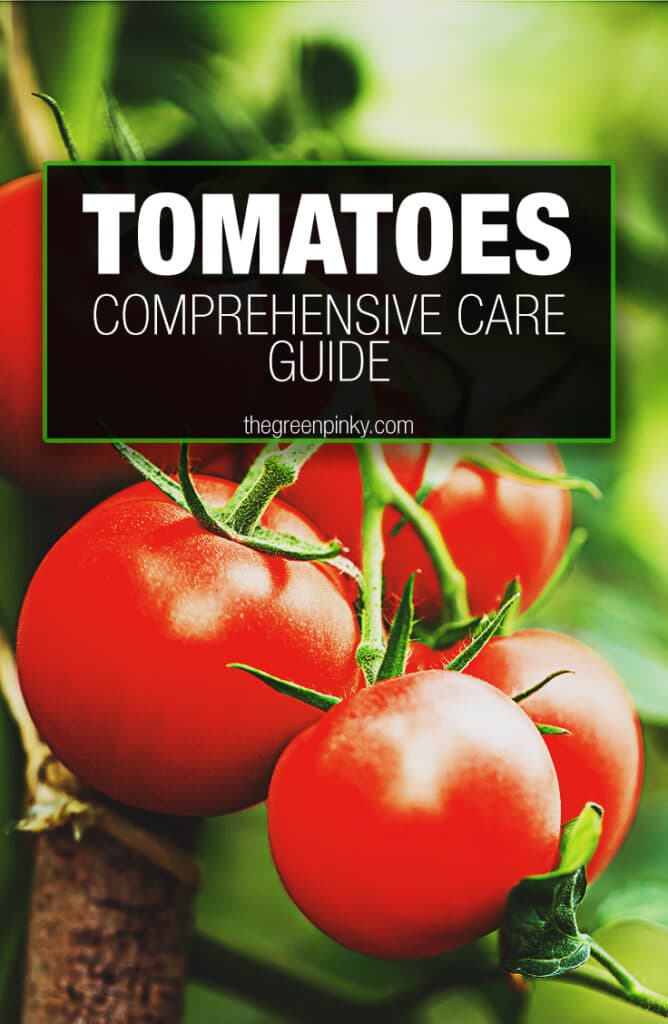
Types
Let’s start by talking about the different types you can grow in your home garden. A quick look at seed products in a catalog can be overwhelming. To simplify the more than ten thousand varieties, they are broken down into seven main types: beefsteak, slicing, plum, grape, cherry, heirloom, and green.
- Beefsteak tomatoes are the largest type; fruits are larger than 4” in diameter. They are great for slicing to use on hamburgers and sandwiches and are well-liked for their juicy interior.
- Slicing tomatoes average 2 to 2.5” in diameter, so they are slightly smaller than beefsteaks. This variety type is high yielding.
- Plum, or paste, tomatoes have lower water content and meatier flesh, making them great for sauces and pastes. They are oblong, reaching 3 to 4” long and 1.5 to 2” in diameter.
- Grape tomatoes are similar in shape to plum varieties but smaller in size.
- Cherry tomatoes are the smallest and round in shape, similar to cherries. They are popular for eating fresh or on salads.
- Heirloom tomatoes vary in size, shape, and color. Their seeds are passed down from generation to generation, and varieties are never cross-pollinated. This lack of cross-pollination leads some people to believe an heirloom variety is a more natural variety.
- Green tomatoes are either varieties bred to be green when fully ripened or that are picked before they are fully ripened. Their tangy, slightly sour taste imparts a unique flavor to dishes compared to ripened, red fruits.
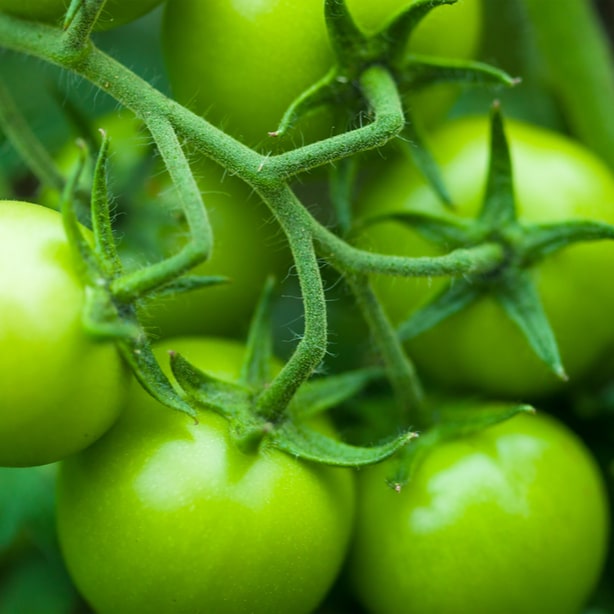
Growth Patterns
When picking what type to grow in your home garden, you should understand that different varieties grow in two main growth patterns. Determinate variety only grow to a predetermined height, and all of the fruit ripens simultaneously; indeterminate varieties continue to grow and set fruit all season, and fruits ripen as they form.
Determinate Varieties
Determinate types have specific characteristics set by the plant’s genetic. They grow to a specific height, and then growth and fruiting stop. All the fruit matures and ripens at the same time, and then the plant starts dying. These plants tend to be smaller and are helpful when you intend to process or can the fruit.
Indeterminate Varieties
Indeterminate types grow opposite of determinate variety. They grow all season with no predetermined height, setting fruit as long as they are actively growing. The fruit matures and ripens as it grows, so there is a slow, steady supply throughout the season. They are suitable for producing fresh tomatoes for a more extended period.
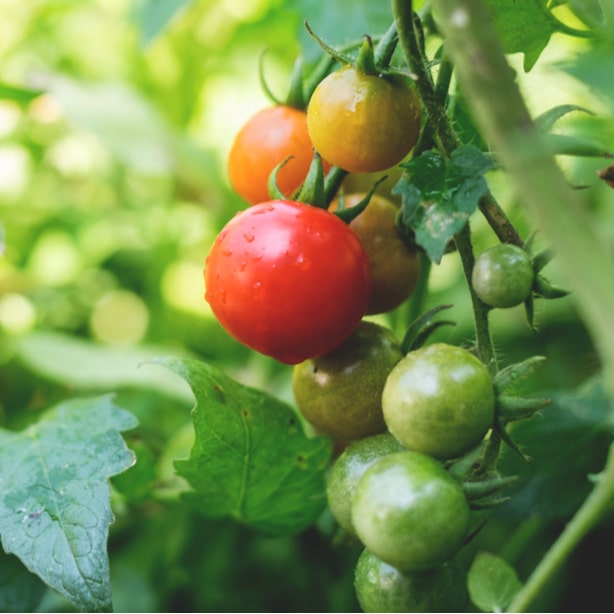
Timing
Tomatoes are considered a warm-season vegetable, so the timing of when to plant is highly dependent upon where you live and the local weather conditions. For plants to grow, night time temperatures need to stay consistently above 50℉; soil temperatures need to be above 60℉. In most growing zones, they should be planted in late spring.
The time it takes plants to mature depends upon the variety and is counted from the time plants are planted in the ground as they are rarely direct sown from seed.
- Early season varieties require 50 to 60 days.
- Mid-season varieties require 60 to 80 days to maturity.
- Late season varieties require more than 80 days.
Starting Seeds Indoors
Tomato plants have a longer growing season than many other vegetables, but the tender plants are susceptible to frost, especially when young. This makes it necessary to start them from seed indoors 6 to 8 weeks before your area’s last average frost date. After the threat of frost passes, they can be transplanted outside.
- Fill a planting tray or other shallow container with a premoistened potting mix.
- Create furrows about ¼” deep in the soil.
- Space seeds every ½”.
- Gently cover the seeds with potting mix.
- Keep the containers at room temperature or slightly above, and the potting soil consistently moist.
- When the seedlings are about a month old, transplant the growing seedlings into a larger, individual container with drainage holes.
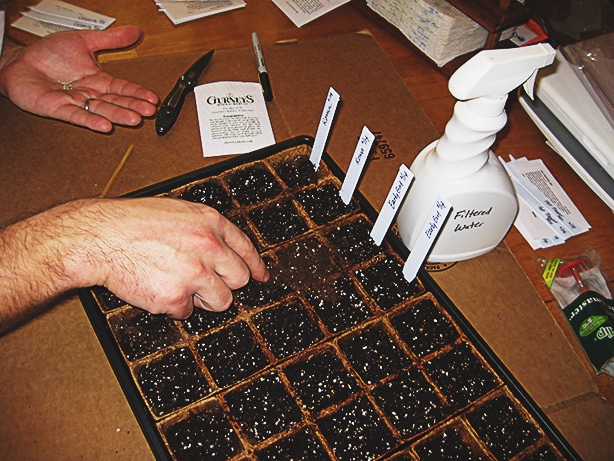
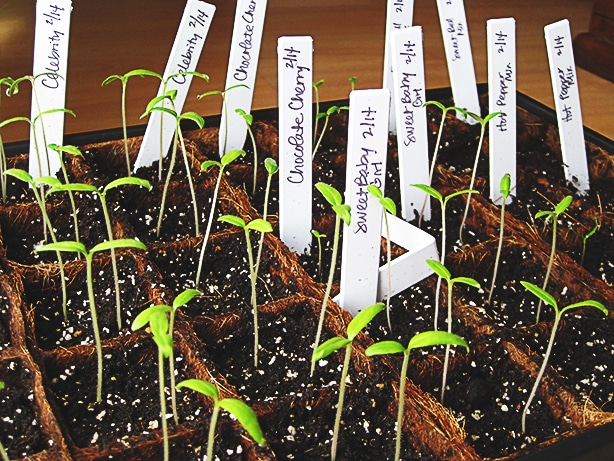
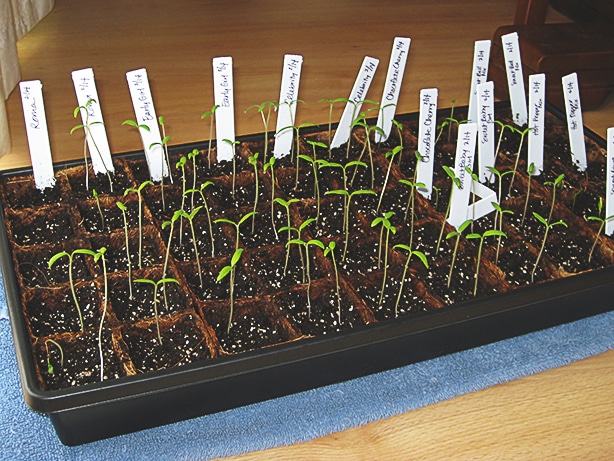
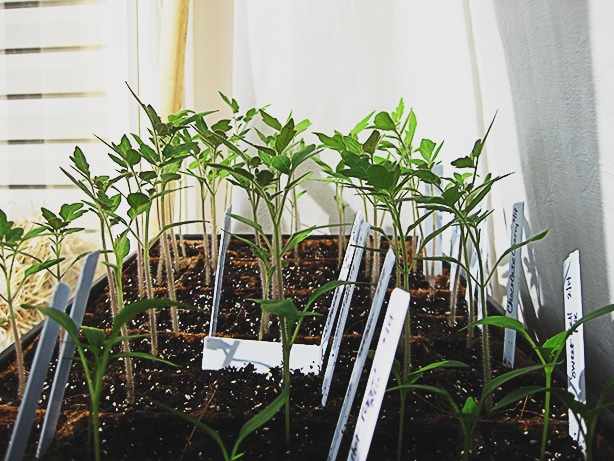
Gardeners living in USDA growing zones 10 and 11 can skip this step and sow seeds directly into the soil. You can also skip this step if you buy plants from a local garden center or nursery, using them in place of ones you start from seed and plant them directly into the garden area.
Soil Preparation
A week before transplanting seedlings, prep the planting area by adding a 2-4” layer of finished compost and working it to a depth of 8 to 12”. Ensure the soil is loose and crumbly to let the root system grow down and outward, and water moves through the soil profile quickly.
Hardening Seedlings
When it’s time to move seedlings outdoors, they must acclimate to the climate before transplanting. About a week before you are planting set the planting trays/containers in a protected spot outside for a few hours and bring them in at night. Gradually increase the exposure to wind and sunshine until it’s time to plant.

Make sure to also check out our guide on how to plant tulips in your garden
Plant Spacing
When growing tomatoes, proper spacing ensures each plant has adequate access to sunlight, soil moisture, and essential nutrients. As hard as it is, follow the recommended spacing and plant them at least 2 feet apart. When planted too closely, a plant competes with neighboring vegetable plants, and no one receives the resources needed for optimal growth.
- Space determinate tomatoes about 2 feet apart with 4 feet between rows.
- Space indeterminate tomatoes 2 to 3 feet apart, maintaining 4 feet between rows.
When you transplant, plant them deeply. Many people bury seedlings past their first set of leaves as new roots form along the stem when buried underground. A more robust, expansive root system anchors plants firmly and keeps them growing upright.
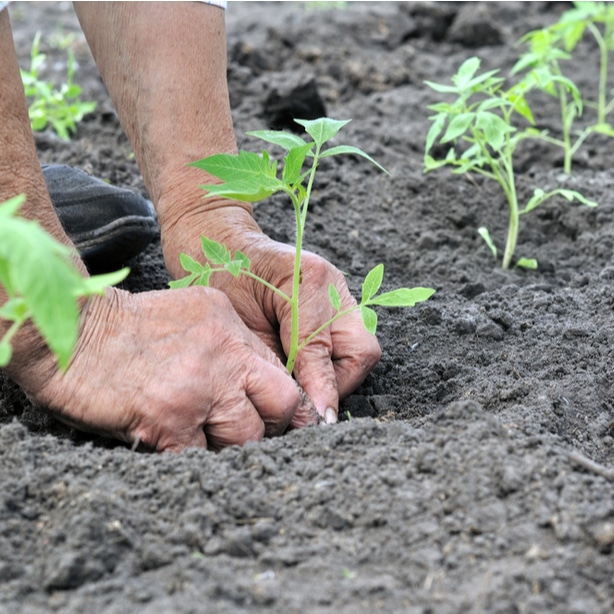
Care Instructions
There are more varieties of tomatoes grown in home gardens than any other vegetables, for a good reason. Gardeners love them for their easy-going nature and low care requirements. When given adequate sunlight, regular water, and fertilizer, and weeds, pests, and diseases are tended to quickly, you’ll be rewarded with the satisfaction of a plentiful, delicious harvest.
Sun Requirements
Like many other garden vegetables, tomatoes grow best in garden spots classified as full sun areas. This means plants need at least 6 hours of sunlight daily but prefer more to meet their photosynthesis needs. If your vegetable garden is considered partial shade instead of full sun, your plants will still grow, but the harvest will be smaller.
Watering Frequency
Due to their quick vegetative growth and the fruit’s high moisture content, keeping plants appropriately watered is vital. During the growing season, keep the soil evenly moist but not soggy, giving plants 1-2” of water a week. Try to water the soil around the base of the plant, keeping it off the foliage.
Fertilization
Tomatoes are classified as heavy feeders, needing a higher amount of plant food than average for optimum growth. Choose a tomato specific fertilizer or an all-purpose fertilizer with lower nitrogen content to promote blossom formation and fruit growth over vegetative growth. Fertilize plants every 6-8 weeks before fruit set; after fruit set, feed every three weeks until harvest.
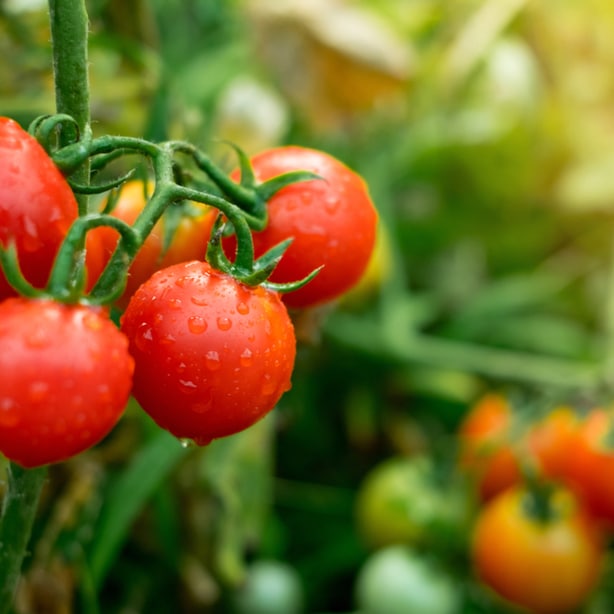
Weeding
To prevent competition from pesky unwanted weeds, frequently check for and remove weeds – either manually or mechanically – when you find them in your vegetable garden. Weeds compete with plants in their proximity, similar to how plants spaced closely together compete for resources such as sunlight, water, and essential plant nutrients.
Pruning
Pruning tomatoes seems counterintuitive – and not many people like the thought of cutting off perfect branches or leaves – but cutting them or trimming them back is an integral part of plant management. It helps prevent disease problems, increases the air circulation through the foliage, improves light penetration into the canopy, and keeps plants manageable in size.
- In young plants, trim the lower leaves off the bottom 12 to 18 inches of the stem using clean, sterilized pruning shears or scissors. Rain can splash diseases in the dirt up onto your tomato leaves if they are not pruned. Remove suckers that develop where the branches attach to the stem. Suckers aren’t harmful, but they pull energy and resources away from the main branches.
- During the growing season, prune back branches that extend into neighboring plants’ growing space or grow inward to the plant’s center. Clear out a few middle branches to improve light penetration and air circulation through the plant’s mid-section.
- Remove any branches or leaves that show signs of mold, blight, or other disease problems to prevent spreading from plant to plant.
- In late summer, top off plants when they outgrow their supports to keep the size manageable and prevent them from getting top-heavy.
Always prune early in the day, giving the wounds time to harden or callous before nightfall.
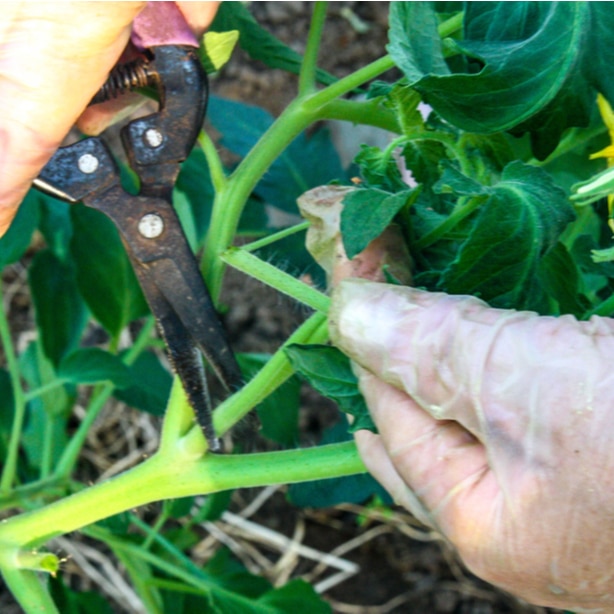
Pest and Disease Management
One of the drawbacks to growing tomatoes is their higher susceptibility to pests and diseases. Regularly inspect your garden, checking for symptoms that suggest either insect or disease problems, and treat appropriately as quickly as possible. When issues are left unattended and allowed to progress, pests and diseases can infect and devastate an entire garden.
- Hornworms feed voraciously, munching their way through foliage and fruit rapidly. They are best controlled by removing them manually.
- Aphids are tiny pear-shaped, lightly-colored insects that attach themselves to the plant and suck the leaves’ sap. Leaves appear distorted and drop if untreated. Wash plants with insecticidal soap or spray with a heavy stream of water.
- Late blight appears as grayish-green water spots on older leaves that darken in color as the disease progresses. Treat with a copper fungicide if caught early. Often the entire stand needs to be removed and discarded.
Growing Tips
As mentioned above, growing tomatoes are pretty straightforward and easy enough for even the novice gardener to handle. Over time, seasoned home gardeners have discovered the following growing tips and tricks that help boost plant growth during the season and lead to better yields. Try them out for yourself to see how they help!
- Add a layer of mulch at the base of young plants, keeping the mulch at least 1 inch from the stems. Mulch helps keep soil evenly moist, prevents weed seeds from germinating, and keeps soil from splashing up onto the leaves when watering.
- Even though they are are self-pollinating, encourage pollinators such as bees to your yard by planting perennials that flower in the spring.
- Water the soil evenly to avoid blossom end rot and fertilize on a schedule to prevent a surge in vegetative growth. Remove and discard any fruits that show signs of blossom end rot.
- Stake or support your plants with cages to keep fruit off of the ground and prevent heavy branches from snapping. When fully loaded, a tomato plant is considerably heavy.
- Cover plants with shade cloth during heatwaves to avoid fruit from sunscald, creating pale, leathery patches on the skin.
- Sidedress plants with Epsom salts to give them extra magnesium.
- Sprinkle crushed up eggshells around the base of plants. The jagged edges keep slugs and snails at bay; the shells add needed calcium to the garden soil.
- Allow the fruits to fully mature on the vine before picking them to get the best, most robust flavor.
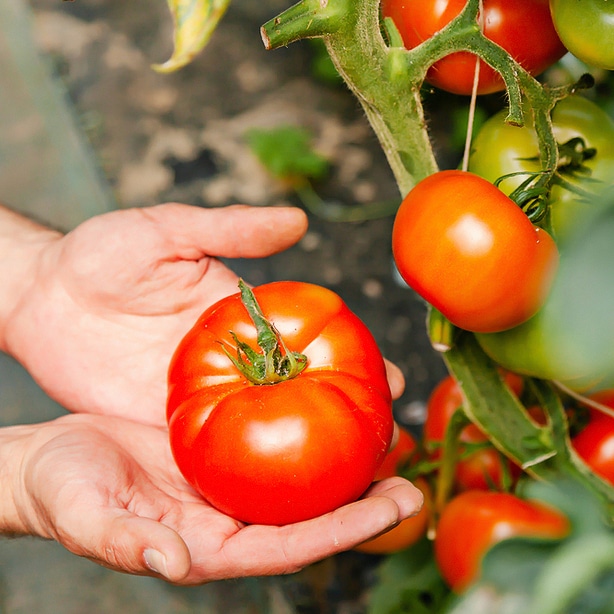
Companion Plants
When growing tomatoes in a vegetable garden, it’s essential to know what plants grow well together – these are known as companion plants – and what plants do not make good neighbors. This knowledge helps to make sure they thrive. Fortunately, they make excellent companion plants to some herbs, fruits, and vegetables you may already grow.
The best companion plants include:
- Asparagus
- Basil
- Borage
- Carrots
- Garlic
- Lettuce
- Marigolds
- Parsley
- Squash
On the flip side, there are vegetables you shouldn’t plant as neighbors. These vegetables and herbs can be chemically incompatible, attract pests that are dangerous to growing tomatoes, or can affect the taste:
- Broccoli
- Brussels sprouts
- Cabbage
- Corn
- Dill
- Fennel
- Peppers
- Potatoes

